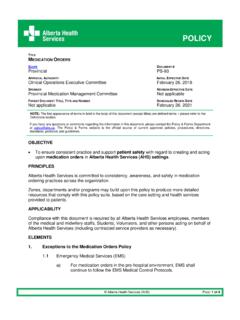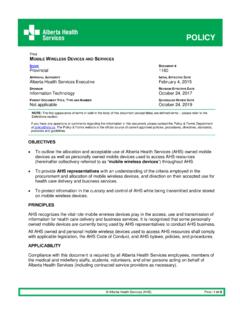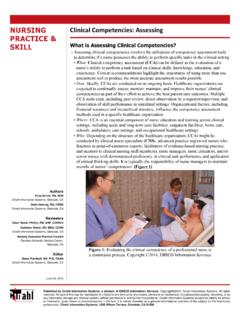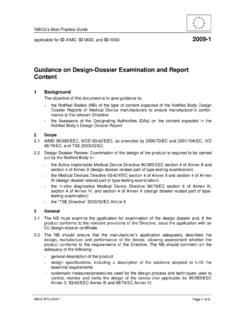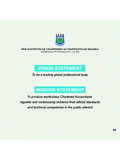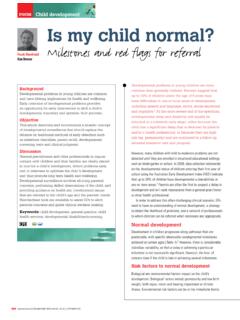Transcription of YPERBILIRUBINEMIA SCREENING A TREATMENT ELL EWBORN …
1 GUIDELINE. TITLE. HYPERBILIRUBINEMIA SCREENING , assessment AND TREATMENT (WELL NEWBORN. GREATER THAN 35 WEEKS GESTATION). SCOPE DOCUMENT #. Provincial: Postpartum and Well Newborn Units HCS-238-01. APPROVAL AUTHORITY INITIAL EFFECTIVE DATE. Vice President, System Innovations & Programs June 10, 2019. SPONSOR REVISION EFFECTIVE DATE. Maternal, Newborn, Child & Youth Strategic Clinical Network August 12, 2019. PARENT DOCUMENT TITLE, TYPE AND NUMBER SCHEDULED REVIEW DATE. Not applicable June 10, 2022. NOTE: The first appearance of terms in bold in the body of this document (except titles) are defined terms please refer to the Definitions section. If you have any questions or comments regarding the information in this document, please contact the Policy & Forms Department at The Policy & Forms website is the official source of current approved policies, procedures, directives, standards, protocols and guidelines. OBJECTIVES.
2 To reduce the incidence of severe hyperbilirubinemia and related consequences in otherwise healthy term and late preterm newborns by: o identifying newborns at risk for hyperbilirubinemia;. o identifying neonatal hyperbilirubinemia in a timely and accurate manner;. o providing timely interventions and/or TREATMENT (s) as required; and o ensuring appropriate follow-up in the community after hospital discharge. PRINCIPLES. Prevention of bilirubin encephalopathy in the newborn requires clinical assessment and management of hyperbilirubinemia. Universal SCREENING for newborn hyperbilirubinemia using either total serum bilirubin (TSB) or transcutaneous bilirubinometry (TcB) should occur prior to the period of highest risk, which is 72 hours following birth. SCREENING helps to determine the risk for newborn hyperbilirubinemia and facilitates anticipatory and effective management. The late preterm infant is more susceptible to hyperbilirubinemia.
3 Use of TcB SCREENING is highly effective. TcB is objective, non-invasive, and reduces the likelihood that a clinically significant TSB level will be missed, while significantly reducing the number of serum bilirubin measurements required. TcB results are available immediately, so there is no delay in measurement of the bilirubin level. Alberta Health Services (AHS) PAGE: 1 OF 20. GUIDELINE. TITLE EFFECTIVE DATE DOCUMENT #. HYPERBILIRUBINEMIA SCREENING , assessment AND TREATMENT (WELL August 12, 2019 HCS-238-01. NEWBORN GREATER THAN 35 WEEKS GESTATION). APPLICABILITY. Compliance with this document is required by all Alberta Health Services employees, members of the medical and midwifery staffs, Students, Volunteers, and other persons acting on behalf of Alberta Health Services (including contracted service providers as necessary). ELEMENTS. 1. Points of Emphasis Implementation of this guideline shall be in accordance with the AHS Consent to TREATMENT /Procedure(s) Policy Suite.
4 The intended application of this guideline is for the assessment and management of early acute jaundice in newborns between 12 hours and approximately 10. days of life. This guideline is not applicable to situations of prolonged or pathological jaundice and is not intended for use in the Neonatal Intensive Care Unit (NICU) setting. A TSB SCREENING shall be performed immediately on any newborn in the first 24. hours of life that appears to be jaundiced. A TcB or TSB SCREENING should be performed on all newborns in the first 24. hours of life, in accordance with a structured jaundice management plan. Newborns' guardians and families should be encouraged to be active partners with the healthcare team in order to improve outcomes with neonatal hyperbilirubinemia. Effective phototherapy should be recommended as part of a TREATMENT plan: a) to prevent severe hyperbilirubinemia in newborns with elevated TSB. concentrations; and b) as initial therapy in newborns with severe hyperbilirubinemia.
5 Breastfeeding support should be provided to all breastfeeding mothers and their newborns to minimize the risk of hyperbilirubinemia. 2. Identification of Hyperbilirubinemia The Registered Nurse (RN) or Licensed Practical Nurse (LPN) with the training to recognize hyperbilirubinemia shall clinically assess the newborn for jaundice in the first 24 hours of life and then every 24 hours until hospital discharge. assessment should be completed as needed and may include but is not limited to: a) visual examination of the sclera, mucous membranes, and blanching of skin (to occur in a well-lit area);. Alberta Health Services (AHS) PAGE: 2 OF 20. GUIDELINE. TITLE EFFECTIVE DATE DOCUMENT #. HYPERBILIRUBINEMIA SCREENING , assessment AND TREATMENT (WELL August 12, 2019 HCS-238-01. NEWBORN GREATER THAN 35 WEEKS GESTATION). b) assessment of cuing and effective feeding, hydration status, and adequacy of output and stooling;. c) daily weight assessment if there are feeding concerns; and d) level of alertness, lethargy, and excessive or high-pitched crying.
6 TcB or TSB levels shall be measured in every newborn between 12-24 hours of life and as close to discharge from hospital as possible if discharged prior to 24. hours of life. Newborns who remain in hospital for longer than 24 hours should have repeat TcB SCREENING performed every 24 hours, and within 12 hours of discharge. All newborns shall be assessed by the health care professional for risk factors of hyperbilirubinemia which should be considered in conjunction with the clinical assessment and TcB/TSB results. Predictive risk includes factors that determine how likely is it that the newborn may need TREATMENT for jaundice. These factors include: a) early onset jaundice ( visible jaundice observed in the first 24 hours, and/or visible jaundice observed before discharge at any age);. b) less than 38 weeks gestation;. c) sibling who required phototherapy as a newborn;. d) significant bruising;. e) cephalohematoma.
7 F) male;. g) maternal age greater than 25 years;. h) Southeast-Asian, Mediterranean, African, Middle Eastern descent;. i) breastfeeding with poor weight gain; or j) dehydration. Susceptibility risk includes factors that increase the risk of encephalopathy. These factors play a role in determining the newborn's designated risk line and potential need for TREATMENT on the phototherapy and exchange transfusion graph (see medium risk line legend in Appendix D below). These factors include: a) history of birth asphyxia;. b) sepsis/acidosis;. Alberta Health Services (AHS) PAGE: 3 OF 20. GUIDELINE. TITLE EFFECTIVE DATE DOCUMENT #. HYPERBILIRUBINEMIA SCREENING , assessment AND TREATMENT (WELL August 12, 2019 HCS-238-01. NEWBORN GREATER THAN 35 WEEKS GESTATION). c) lethargy;. d) temperature instability;. e) isoimmune hemolytic disease (DAT positive);. f) G6PD deficiency; or g) respiratory distress. The process for SCREENING the newborn with a gestational age of greater than 35.
8 Weeks for the risk of the development of hyperbilirubinemia is outlined in Appendix A: Acute Care SCREENING and Management for Hyperbilirubinemia. 3. TcB Measurement If available, a newborn's bilirubin level should be measured with a transcutaneous bilirubin meter (TcB meter). TcB measurement should only be performed using a meter that has been correctly validated according to Point of Care program standards on: a) newborns equal to or less than 10 days of life;. b) newborns who have not received phototherapy; and c) newborns who have not received an exchange transfusion. TcB measurements shall only be performed by health care professionals who have successfully completed the AHS Point of Care Testing Jaundice Meter education resource for the TcB meter used in their practice setting. The health care professional shall perform the TcB measurement using the method described by the AHS Point of Care Testing Jaundice Meter program.
9 TcB measurements shall only be taken with a TcB meter that meets AHS lab services point-of-care quality control requirements. Either the forehead or the sternum may be used as the TcB measurement site providing that the location is consistently used and identified, and the measurements documented in the newborn's health record. To manage the TcB results, see Section 4 below for communities without an established community TcB SCREENING program or Section 5 below for communities with an established community TcB SCREENING program. 4. Management of TcB and TSB Results for Communities Without an Established Community TcB SCREENING Program (All Communities Outside of Calgary Zone - Urban). Alberta Health Services (AHS) PAGE: 4 OF 20. GUIDELINE. TITLE EFFECTIVE DATE DOCUMENT #. HYPERBILIRUBINEMIA SCREENING , assessment AND TREATMENT (WELL August 12, 2019 HCS-238-01. NEWBORN GREATER THAN 35 WEEKS GESTATION). TcB levels and/or TSB levels should be plotted by the RN or LPN on the Bhutani predictive nomogram as per Appendix B below.
10 A) The zone in which the value falls will predict the risk of the newborn developing hyperbilirubinemia. Refer to Appendix C below. If the TcB or TSB level plots on the Bhutani predictive nomogram in the low or low-intermediate risk zone (see Appendix B below), only routine care is required ( , continue TcB or TSB testing every 24 hours while in hospital). If the TcB level plots on the Bhutani predictive nomogram in the high- intermediate or high risk zone (see Appendix B below), a TSB level should be drawn to determine if further investigation, initiation of phototherapy, or other management is required. TSB levels that plot in the high-intermediate or high risk zone on the Bhutani predictive nomogram shall also be plotted by the RN or LPN on the Indication for Phototherapy or Exchange Transfusion graph as per Appendix D below, to determine appropriate management. Notify the most responsible health practitioner (MRHP).



